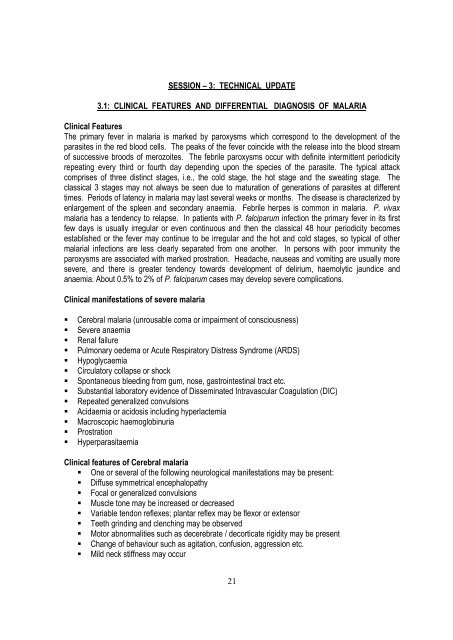training module for medical officers primary health centre - NVBDCP
training module for medical officers primary health centre - NVBDCP
training module for medical officers primary health centre - NVBDCP
- No tags were found...
Create successful ePaper yourself
Turn your PDF publications into a flip-book with our unique Google optimized e-Paper software.
SESSION – 3: TECHNICAL UPDATE3.1: CLINICAL FEATURES AND DIFFERENTIAL DIAGNOSIS OF MALARIAClinical FeaturesThe <strong>primary</strong> fever in malaria is marked by paroxysms which correspond to the development of theparasites in the red blood cells. The peaks of the fever coincide with the release into the blood streamof successive broods of merozoites. The febrile paroxysms occur with definite intermittent periodicityrepeating every third or fourth day depending upon the species of the parasite. The typical attackcomprises of three distinct stages, i.e., the cold stage, the hot stage and the sweating stage. Theclassical 3 stages may not always be seen due to maturation of generations of parasites at differenttimes. Periods of latency in malaria may last several weeks or months. The disease is characterized byenlargement of the spleen and secondary anaemia. Febrile herpes is common in malaria. P. vivaxmalaria has a tendency to relapse. In patients with P. falciparum infection the <strong>primary</strong> fever in its firstfew days is usually irregular or even continuous and then the classical 48 hour periodicity becomesestablished or the fever may continue to be irregular and the hot and cold stages, so typical of othermalarial infections are less clearly separated from one another. In persons with poor immunity theparoxysms are associated with marked prostration. Headache, nauseas and vomiting are usually moresevere, and there is greater tendency towards development of delirium, haemolytic jaundice andanaemia. About 0.5% to 2% of P. falciparum cases may develop severe complications.Clinical manifestations of severe malariaCerebral malaria (unrousable coma or impairment of consciousness)Severe anaemiaRenal failurePulmonary oedema or Acute Respiratory Distress Syndrome (ARDS)HypoglycaemiaCirculatory collapse or shockSpontaneous bleeding from gum, nose, gastrointestinal tract etc.Substantial laboratory evidence of Disseminated Intravascular Coagulation (DIC)Repeated generalized convulsionsAcidaemia or acidosis including hyperlactemiaMacroscopic haemoglobinuriaProstrationHyperparasitaemiaClinical features of Cerebral malaria One or several of the following neurological manifestations may be present: Diffuse symmetrical encephalopathy Focal or generalized convulsions Muscle tone may be increased or decreased Variable tendon reflexes; plantar reflex may be flexor or extensor Teeth grinding and clenching may be observed Motor abnormalities such as decerebrate / decorticate rigidity may be present Change of behaviour such as agitation, confusion, aggression etc. Mild neck stiffness may occur21
















